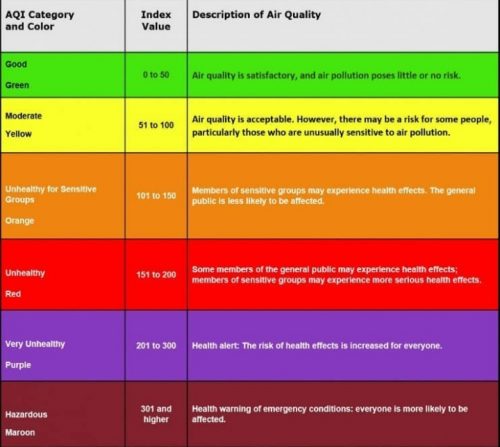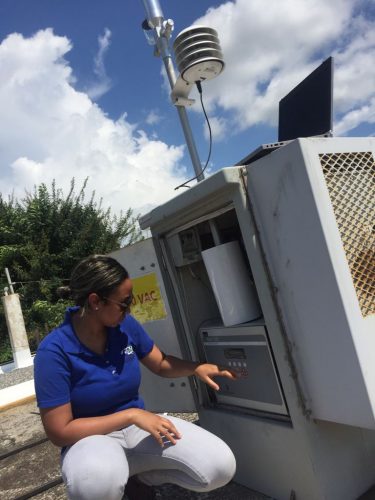Monitor Air Quality for Respiratory Health
By: , August 10, 2021The Full Story
According to the World Health Organization (WHO) 4.2 million deaths occur each year as a result of exposure to ambient air pollution with low- and middle-income countries experiencing the highest burden from this type of pollution. Some pollutants are emitted into the air and others are formed in the air from chemical reactions to the emissions. Of great concern is the pollutant particulate matter, which is a key indicator of air quality.
There are many activities that generate particulate matter, like motor vehicle emissions, construction and open burning like bush fires. Even the Saharan dust plume can generate particulate matter.
“When we speak of particulate matter, we’re talking about minute particles suspended in air that consist of a mixture of solid and often liquid material. The particles are made up of many different substances and chemicals depending on the aetiology or cause of the particulate matter. There may be acids, minerals and metals such as lead and copper, as well as other substances such as dirt, soot, or smoke. Particulate matter comes in varying sizes and shapes. They are of concern from an environmental pollution standpoint, as well as presenting a real health hazard,” Senior Medical Officer at the National Chest Hospital and Pulmonologist, Dr. Terry Baker explains to JIS News.
Particulate matter ranges from those that are coarse, about 10 micrometers (PM10), to fine particles, about 2.5 micrometers (PM2.5). Those below the latter size are ultrafine particles but regardless of their size, particulate matter should be of great concern, especially to persons with underlying health issues.
Dr. Baker shares that the larger particles, due to their size, often get trapped in the upper airway such as the nostrils and throat and tend not to diffuse into the lungs as easily as their smaller counterparts. Inhalation of larger particulate matter may result in upper respiratory tract irritation, which may manifest as itching of the nostrils, increased mucus production and allergic reactions causing sniffling, sneezing and nasal congestion. These larger particulates may also cause redness and itching of the eyes, ears and skin.
The fine particulate matter, which can be 20 times smaller than a strand of human hair, has the potential to go deeper into lung tissues and can also get into our bloodstream.
“The smaller particles (PM2.5) are the ones that are often more worrisome. These finer particles when inhaled, readily deposit deep within the lung. They are therefore of particular concern to persons with underlying respiratory illnesses such as asthma and chronic obstructive pulmonary disease (COPD), including emphysema and chronic bronchitis. The particles may cause a sudden worsening or exacerbation of the underlying conditions, with increasing cough, shortness of breath, wheezing and chest discomfort requiring medical attention, and for some persons even hospitalisation. Long-term exposure to high concentrations of particulate matter has been associated with increased risk of lung cancer. Children and some adults are at risk of recurrent pneumonias and worsening lung function,” Dr. Baker shares.
“The concern is not just for lung or respiratory health, but also for persons with underlying heart disease, particularly coronary artery disease. These are persons who may have had a heart attack or a history of angina – heart-related chest pain. Persons with diabetes are also at an increased risk of having coronary artery disease. There is an increased risk of worsening heart disease, irregular heartbeats, heart attacks, hypertension and even death on exposure to pollution due to particulate matter,” she continues.
Minister of Health and Wellness, Dr. the Hon. Christopher Tufton, recently shared figures on non-communicable diseases (NCD) such as those listed above, and explained that having one NCD puts you at risk of developing others. Of the average 18,000 deaths a year, 70% are from non-communicable diseases.
Citing the adverse health effects of exposure to particulate matter, the WHO published an annual average guideline for PM10 and PM2.5 to help cities and countries monitor air pollution and take the necessary actions to reduce local air pollution.
Using these guidelines, the National Environment and Planning Agency (NEPA) monitors local air quality for PM2.5 from its air quality monitoring stations. Using the air quality index which ranges from a low of zero to a high of 500, NEPA can tell how clean or polluted the air is and issues an advisory to the public if the levels are unhealthy for sensitive groups.
“What we’re doing at this time is that we prepare that air quality index, we look at what kind of days are we expecting, and then we will share across the different teams or media platforms. In this regard, the public is able to take some extra precaution in keeping with what they have heard … along with other announcements. We did, in fact, last year, work a bit with IQ Air and … this company allowed us to use satellite data. So, we worked with them to pin stations that would give us an idea based on what’s coming into the air from Africa, and in general what the concentrations might be like,” says Acting Manager of NEPA’s Air Quality Management Branch, Shannen Suckra.
The air quality index also uses colour codes for each category of pollution with green indicating good; yellow for moderate; orange when it is unhealthy for sensitive groups; red when the air is deemed unhealthy; purple for very unhealthy; and maroon for hazardous.

Although most persons may not have control over the release of particulate matter from activities like transportation, construction and industry, there is one area that is within the power of the average Jamaican. Both Ms. Suckra and Dr. Baker agree that open burning in an already polluted environment exacerbates air pollution, especially since it is difficult to determine what types of particulate matter are released into the air from fires.
“In areas or circumstances when there is high particulate matter pollution, persons with underlying lung and heart disease are at risk of worsening of their conditions. These persons are therefore encouraged to wear masks, preferably masks designed to filter these small particles, although any mask is better than no mask at all. Persons should reduce exposure by avoid going outside if possible and should consider getting air filters or air purifiers for their homes.
“Persons with chronic illnesses are to ensure they have sufficient medication and are encouraged to take medication as prescribed. Options such as telephone calls to the doctor/pharmacy or telemedicine may need to be explored to avoid going outdoors. Exercise or strenuous activity, particularly if outdoor when particulate matter levels are high, is not encouraged for persons at risk,” advises Senior Medical Officer, Dr. Terry Baker.
Part of the preparation is utilising air quality index resources available online, in conjunction with local information.
“IQ Air is another good source of information that you could perhaps look at, to get general information for what’s expected. Remember that information from most of these sources that you would find online are in fact satellite data. They do not have any information from our local monitoring network. So, while it may give you a general idea of what’s coming, or what’s happening…our monitors on the ground will give us more useful information. So that’s why it’s important to look out for our advisories as well and on the NEPA website we post periodic updates,” adds Ms. Suckra.

There is also an IQ Air app available for download on mobile devices and information is also available on NEPA’s social media pages @nepajamaica on Instagram and Twitter.


